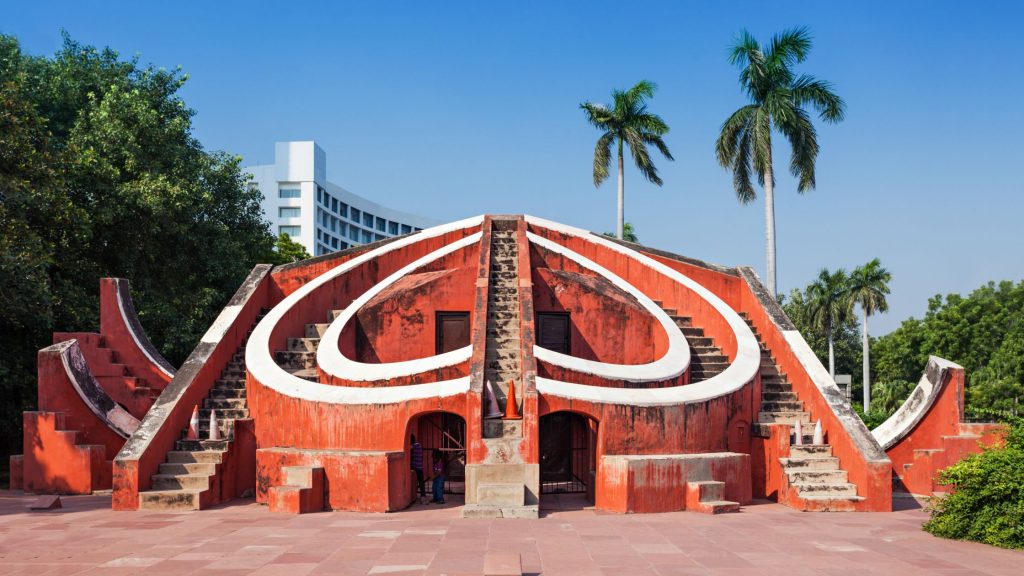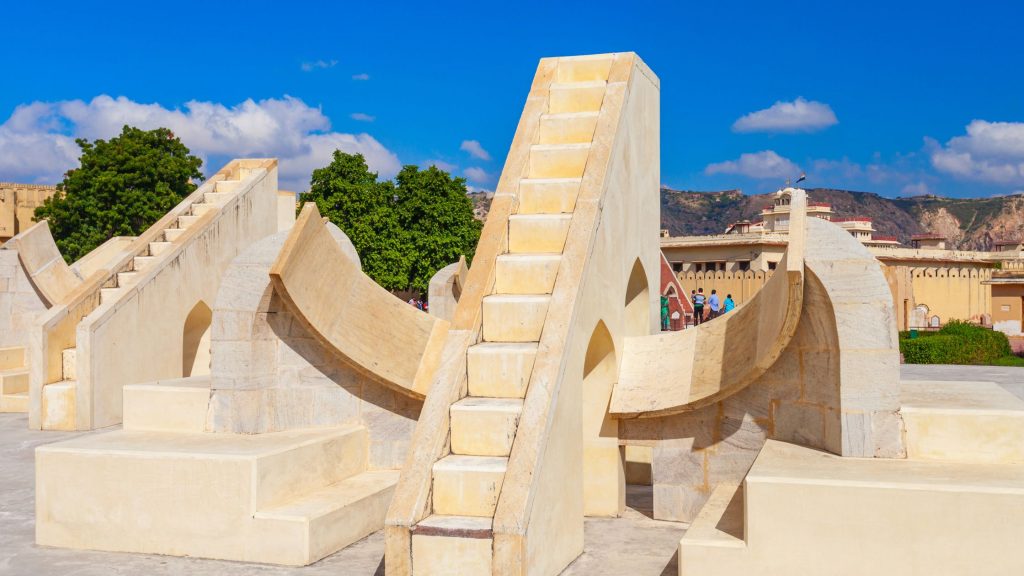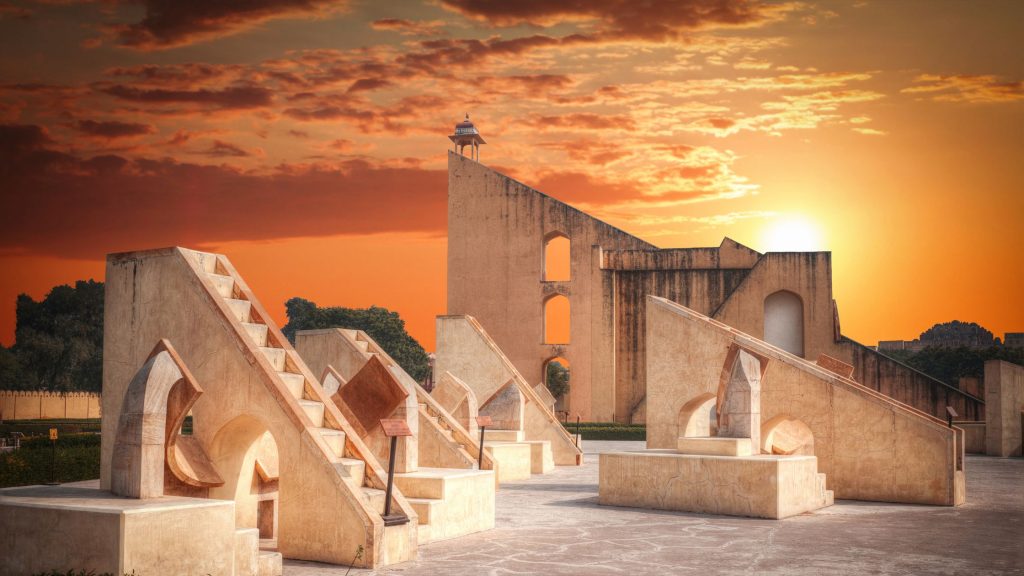Contents
Jantar Mantar Delhi
Jantar Mantar, an awe-inspiring architectural marvel, graces the modern city of New Delhi. The term “Jantar Mantar” translates to “instruments for measuring the harmony of the heavens.” Constructed in 1724 by Maharaja Jai Singh II of Jaipur, this observatory boasts 13 intricate astronomical instruments. Maharaja Jai Singh II was a distinguished ruler of the 18th century, and his profound interest in astronomy led to the creation of this extraordinary site. In this article, we will delve into the history and significance of Jantar Mantar, along with the purposes of its distinct structures.
History of Jantar Mantar
Jantar Mantar is the earliest among the five observatories built by Maharaja Jai Singh II during his rule. The other four observatories are located in Ujjain, Mathura, Varanasi, and Jaipur. The primary purpose behind the construction of these observatories was to gather precise astronomical data and accurately predict the movements of celestial bodies in the solar system. When it was built, Jantar Mantar was a pioneering feat of architecture and astronomy. However, over time, the observatory underwent considerable decay during British rule, particularly by the year 1867.

Jantar Mantar Delhi Timings
The operating hours of Jantar Mantar are from sunrise to sunset, welcoming visitors from 6 am to 6 pm.
Monday to Sunday – 6 am to 6 pm
How to reach Jantar Mantar Delhi
Located at the heart of Delhi, Jantar Mantar is easily accessible through various modes of transportation. The most convenient option is to use the metro or city buses that operate in central Delhi. The nearest metro stations are Rajiv Chowk, Patel Chowk, and Janpath Metro stations are within a distance of 1 km. Alternatively, you can opt for an auto-rickshaw or hire a taxi for a comfortable journey. While visiting Jantar Mantar, take the opportunity to explore other prominent places in Delhi, including Connaught Place, Khan Market, and Janpath. Jantar Mantar is conveniently situated in the city center, in close proximity to several significant landmarks of New Delhi. You can find it at Sansad Marg, Connaught Place, New Delhi, 110001.
Jantar Mantar Delhi Online Ticket Booking & Price
You can save time and avoid the hassles of waiting in long queues to get your entry tickets online here. Ticket Price for Jantar Mantar in Delhi is as follows :
| Indian | Rs 15 |
| SAARC and BIMSTEC | Rs 15 |
| Foreigner | Rs 200 |
| Video Photography | Rs 25 |

The Purpose of Individual Structures
1. Samrat Yantra
The Samrat Yantra, also known as the Supreme Instrument, is an immense triangle functioning as an equal hour sundial. Rising to an impressive height of 70 feet and measuring 114 feet at the base, this instrument has a hypotenuse of 128 feet, parallel to the Earth’s axis and pointing towards the North Pole. It features quadrants with graduations indicating hours, minutes, and seconds. While sundials existed before the Samrat Yantra, this instrument revolutionized celestial measurements, allowing for precise calculations of declination and other coordinates of heavenly bodies. It is considered the world’s largest sundial and can calculate local time with an accuracy of up to two seconds.
2. Jaya Prakash Yantra
The Jaya Prakash Yantra comprises hollowed-out hemispheres with markings on their concave surfaces. Crosswires were stretched between points on their rim. This instrument was designed to help observers align the position of a star with various markings or a window’s edge. Its versatility allows it to provide the coordinates of celestial objects in multiple systems, including the Azimuthal-altitude system and the Equatorial coordinate system, facilitating easy conversation between different celestial systems.
3. Rama Yantra
The Rama Yantra consists of two large cylindrical structures with open tops, enabling the measurement of star altitudes based on the latitude and longitude of the observer on Earth. It served as a valuable instrument for astronomers to determine the position of stars accurately.
4. Misra Yantra
The Misra Yantra, meaning “mixed instrument,” is a unique composition of five instruments aimed at determining the shortest and longest days of the year. Additionally, it could indicate the exact moment of noon in various cities and locations, regardless of their distance from Delhi. Unlike the other structures in the observatory, the Misra Yantra was not invented by Maharaja Jai Singh II.

5. Shasthansa Yantra
Using a pinhole camera mechanism, the Shasthansa Yantra is built within the towers that support the quadrant scales. This instrument is used to measure specific attributes of the sun, such as zenith distance, declination, and the sun’s diameter.
6. Kapala Yantra
Built on the same principle as the Jaya Prakash Yantra, the Kapala Yantra serves as a demonstration to indicate the transformation of one coordinate system to another. While not used for active celestial observation, it plays a vital role in understanding celestial coordinates.
7. Rasivalya Yantra
A total of twelve Rasivalya Yantras were built, each referring to a zodiacal constellation. These structures measure the latitude and longitude of celestial objects when they cross the meridian, providing crucial astronomical data.
Jantar Mantar stands as a testament to the brilliance of Maharaja Jai Singh II and the advancements in astronomical science during the 18th century. This remarkable observatory in New Delhi continues to intrigue visitors with its extraordinary architectural astronomy instruments. Despite its historical decay, Jantar Mantar remains a cherished heritage site, reminding us of the rich astronomical heritage of India and the pursuit of knowledge in understanding the harmony of the heavens. So, if you ever find yourself in New Delhi, don’t miss the opportunity to explore the wonders of Jantar Mantar and experience the legacy of Maharaja Jai Singh II.
Leave a Reply